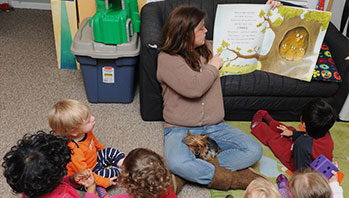- Roller Coaster (book)
- dip
- dive
- down
- roller coaster
- slant
- slide (n.)
- up
- zip
- zoom
MA Standards:
English Language Arts/Literature/RL.PK.MA.1: With prompting and support, ask and answer questions about a story or a poem read aloud.
English Language Arts/Literature/RL.PK.MA.7: With prompting and support, make predictions about what happens next in a picture book after examining and discussing the illustrations.
English Language Arts/Literature/RL.PK.MA.4: With prompting and support, ask and answer questions about unfamiliar words in a story or poem read aloud.
English Language Arts/Literature/RL.PK.MA.9: With prompting and support, make connections between a story or poem and one’s own experiences.
Head Start Outcomes:
Literacy Knowledge/Book Appreciation and Knowledge: Asks and answers questions and makes comments about print materials.
Language Development/Expressive Language: Engages in communication and conversation with others.
Language Development/Expressive Language: Uses language to express ideas and needs.
PreK Learning Guidelines:
English Language Arts/Reading and Literature 7: Develop familiarity with the forms of alphabet letters, awareness of print, and letter forms.
English Language Arts/Reading and Literature 6: Listen to a wide variety of age appropriate literature read aloud.
English Language Arts/Reading and Literature 10: Engage actively in read-aloud activities by asking questions, offering ideas, predicting or retelling important parts of a story or informational book.
Read Together: Roller Coaster #1

© Commonwealth of Massachusetts, Department of Early Education and Care (Jennifer Waddell photographer). All rights reserved.
STEM Key Concepts: A ramp, or inclined plane, is a surface with one end higher than the other
ELA Focus Skills: Making Connections, Speaking and Listening, Story Comprehension, Vocabulary
Hold up Roller Coaster by Marla Frazee. Tell children you are going to read a story about a girl who goes on her first roller coaster ride.
- Then hold up the spread of the big roller coaster and identify the parts of the roller coaster: tracks, car, loops, etc.
- Set a focus for children by asking them to notice what happens when the roller coaster car goes up and down the hills.
Before You Read
Hold up the book and ask children to describe what they see on the cover. Point to the direction the roller coaster car is moving and then point out how the title is going in the same direction. Ask,
- What do you notice about the direction the roller coaster car is moving in?
- When you look at the picture, how do you know it is going downhill? (slanted down, people leaning back) Make the connection that it is slanted down just like a slide.
- Why do you think the title is written like it is moving down the page? (mimic the downhill motion of the roller coaster)
As You Read
Trace the roller coaster’s route along the tracks with your finger to show how the roller coaster goes up, down, and loops around.
- Ask, Why do you think some people change their mind about riding the roller coaster at the last minute? (as they get closer they see how fast the ride goes down the hills and they get scared)
- Pause after reading the first two spreads and ask children to point to someone who they think has never ridden a roller coaster before.
- Read the words clickity, clackity with exaggerated slowness to emphasize the effort needed to pull the roller coaster up the hill. Then read with excitement how the car zips, zooms, dips, and dives as it speeds down the hill, around the curves, and through the loop.
After You Read
Hold up the spread of the big roller coaster and identify parts of the roller coaster: tracks, car, loops, etc. Help children understand how the roller coaster goes fast, loops, dips, etc.
Revisit different pages in the story and invite children to describe what they see. Ask questions such as,
- What does it mean to “dip and dive”? Can you show me with your arms?
- Why do you suppose the author chose to use the words clickety clackety, swoosh, and wheeee?
- Have children mimic the motion words with you as you say each one aloud.
- Ask, Does this book make you think of any of your sliding experiences (sledding, rolling down hills, amusement rides)? How were your experiences like those in the book? How were they different?
